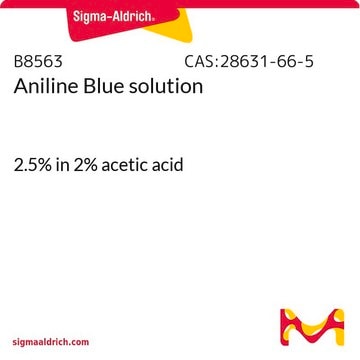F8129
Acid Fuchsin
Powder
Synonyme(s) :
Acid Violet 19, Fuchsin S, Fuchsin acid, Rubine S
About This Item
Produits recommandés
product name
Acid Fuchsin, used in tissue staining
Niveau de qualité
Forme
powder
Composition
Dye content, ~70%
Couleur
blue-green
Solubilité
H2O: 1 mg/mL
Application(s)
diagnostic assay manufacturing
hematology
histology
Température de stockage
room temp
Chaîne SMILES
[Na+].[Na+].Cc1cc(cc(c1N)S([O-])(=O)=O)\C(c2ccc(N)c(c2)S([O-])(=O)=O)=C3/C=CC(=N)C(=C3)S(O)(=O)=O
InChI
1S/C20H19N3O9S3.2Na/c1-10-6-13(9-18(20(10)23)35(30,31)32)19(11-2-4-14(21)16(7-11)33(24,25)26)12-3-5-15(22)17(8-12)34(27,28)29;;/h2-9,23H,21-22H2,1H3,(H,24,25,26)(H,27,28,29)(H,30,31,32);;/q;2*+1/p-2
Clé InChI
WZRZTHMJPHPAMU-UHFFFAOYSA-L
Vous recherchez des produits similaires ? Visite Guide de comparaison des produits
Catégories apparentées
Description générale
Application
Code de la classe de stockage
11 - Combustible Solids
Classe de danger pour l'eau (WGK)
WGK 3
Point d'éclair (°F)
Not applicable
Point d'éclair (°C)
Not applicable
Équipement de protection individuelle
dust mask type N95 (US), Eyeshields, Gloves
Certificats d'analyse (COA)
Recherchez un Certificats d'analyse (COA) en saisissant le numéro de lot du produit. Les numéros de lot figurent sur l'étiquette du produit après les mots "Lot" ou "Batch".
Déjà en possession de ce produit ?
Retrouvez la documentation relative aux produits que vous avez récemment achetés dans la Bibliothèque de documents.
Notre équipe de scientifiques dispose d'une expérience dans tous les secteurs de la recherche, notamment en sciences de la vie, science des matériaux, synthèse chimique, chromatographie, analyse et dans de nombreux autres domaines..
Contacter notre Service technique







